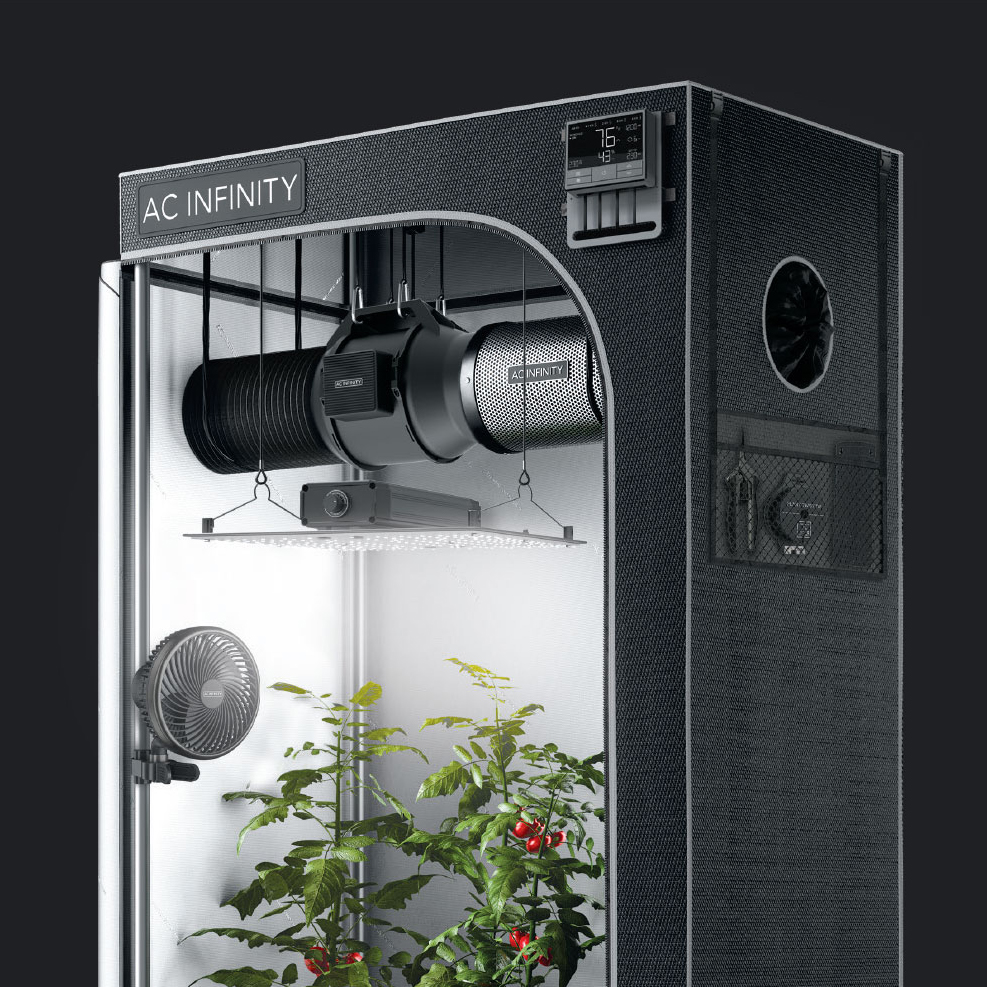To grow indoors, you will need to create the ideal climate conditions for your plant, which involves dialing in the temperature, humidity, and lighting. The quickest and easiest way to achieve this is to use a grow tent, an enclosure that facilitates environmental control while reflecting light. Along with key components to create lighting and airflow, this system will create the perfect self-contained environment for your hemp plant to thrive. These vital pieces include a grow light, inline duct fan, and clip fan.
The first step in choosing a grow tent is deciding on how many plants you plan on growing, and how big they will get. As a reference, a small hemp plant only needs 1-2 ft² (square feet) of floor space, a medium-sized hemp plant requires 3-5 ft² of floor space, and a large hemp plant can take up 6-9 ft² of floor space. Your chosen grow tent’s height will dictate what you grow as well, allowing for a max plant height of [grow tent height] – [1.5 feet] to account for grow light clearance.
For example, if you are looking to grow 2 medium-sized plants that grow up to 4 ft. tall, you will need at least 6 ft² of floor space and a 6 ft. tall grow tent. For this, a 4'x2'x6' grow tent with 8 ft² of floor space or a 3'x3'x6' grow tent with 9 ft² of floor space would be the smallest size that can house them.
Grow Lights
Once you decide on a grow tent, you will need to pair it with an appropriately sized grow light. Grow lights are used to replicate the sun to facilitate photosynthesis, a process where a plant converts light energy into chemical energy. Thus, they are the key determining factor in how fast a plant grows.
When choosing the correct grow light for your given space, you will need to first look at its PPFD coverage map. PPFD is a measurement that combines light intensity with the spectrums of light that a plant can utilize for photosynthesis. This specification is used to help provide the greatest amount of light a plant can utilize to maximize its growth rate.
A hemp plant will need between 200-400 PPFD in the seedling stage, between 400-600 PPFD in the vegetative stage, and between 600-1,000 PPFD in the flowering stage.
Inline Duct Fans
The inline duct fan is the lungs of your grow tent, regularly exchanging the air to bring in fresh CO2 for the plants to breathe in. An inline duct fan also helps regulate your grow tent’s temperature and humidity, while also blocking odors when a carbon filter is attached. Select fans will come with smart regulators that monitor and react to climate conditions, activating it to keep your grow tent within the acceptable temperature and humidity range.
When choosing the correct inline duct fan, you will need to first calculate your grow space in cubic feet by multiplying its length by its width and height. The resulting cubic feet will equal your base required CFM, or cubic feet per minute. [Length] x [Width] x [Height] = # ft³ = Required CFM. For example, a 3’x3’x6’ grow tent is 54 ft³ [3'x3'x6'=54']. The inline duct fan will need to clear out this amount of air once per minute, so for a 3’x3’x6’ grow tent you will need an inline duct fan that is rated for 54 CFM or higher.
Clip Fans
A clip-on fan mimics the outdoor breeze, which helps your plants build stem strength while staving off mold, mildew, and bugs. These come in various sizes and oscillating speeds that help recreate the exact outdoor conditions your plant natively grows. Clip-on fans should be set near your plant's height and grip onto the grow tent frame to stay upright.
You will need enough clip-on fans to provide a breeze that covers all corners of a grow tent, with each oscillating clip fan able to cover up to 9 square feet.
Additional Accessories
Both the clip fan and inline fan will generate noise as it moves air throughout the grow space. Here are a few simple tricks to minimize the noise in your grow space. To lower the duct fan noise, you can either use a larger inline fan to run it at a slower speed, or use install a duct silencer to your ductwork to dampen airflow noise. Decreasing noise from a clip fan by lowering its speed will also reduce its airflow, so we recommend installing an additional clip fan and setting them to half speed.
When hemp plants start to flower, they will produce a distinct smell that can easily spread outside of the grow space. To remove this smell, install a carbon filter onto either end of the inline fan to scrub the air before it exits the grow space.
Adding additional fan accessories like carbon filters and duct silencers will call for doubling your required CFM to compensate for the loss in airflow. This means that for a 3’x3’x6’ grow tent utilizing a carbon filter and trying to minimize the noise produced you will need an inline duct fan rated for 216 CFM (54'x2x2=216').

Complete Plant Kits
Not sure where to start? You may opt for our all-in-one plant kits to cut down on your research and quickly get started. Each bundle is compiled with all the listed tools you need to start an indoor grow of your specific capacity. Choose from one of five different plant kit bundles to fit your needs.




